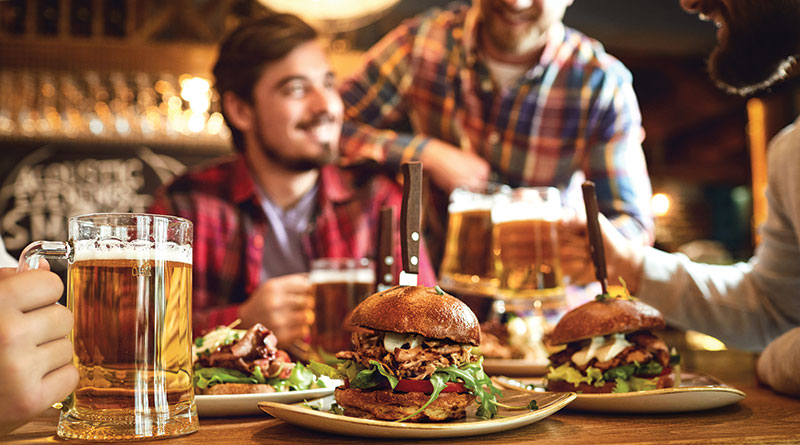‘Double-Digit Growth for Out-of-Home Dining, with Increased Spending Forecast – Research Reveals

Research from consumer advisor Circana, the UK’s foodservice market is experiencing a resurgence. Consumer spending in restaurants, pubs, cafés and quick-service eateries returned to double-digit growth, with a rise of +10% year-on-year. This hunger for out-of-home (OOH) dining is not just a flash in the pan, as forecasts indicate a steady rise of +6% year-on-year in consumer spending throughout 2024, with visits also expected to rise by almost +3%.
When asked about their financial situation over the next six months, 26% of consumers said they were optimistic and expected it to improve. With this increased confidence, nine out of ten consumers (91%) reported that dining out remains comfortably within their budget. Furthermore, almost one-third (32%) asserted that their restaurant-going habits remained unchanged due to their stable finances, reflecting a +13%pp increase in this sentiment compared to last year. While 9% said they could no longer afford to eat out in bars and restaurants.
This surge in dining enthusiasm coincides with a steadily growing population of self-proclaimed ‘foodies’, with the number of people who identified as passionate about food experiences increasing to 21% (+7%pp) compared to 2023.
Seton Leung, Head of UK Foodservice, Circana, said:
“Restaurant-goers are becoming smarter and adapting their spending habits in the eating-out industry. Although consumers are becoming more optimistic in their personal financial situations, the fact remains that the cost of eating out is a lot higher than it has been in the past, and one of the most popular money saving techniques is for consumers to seek out promotions.
“The alternative is that consumers will drop items from their order, or simply visit bars and restaurants less often. To mitigate the latter from happening it is important for restaurants to promote money-saving incentives to try to win back some of the lost footfall following heavy price inflation, given that a third of Brits claim to still be able to afford eating out.”
UK diners remain cautious amidst rising costs
However, Circana’s research also highlighted a notable gap in the return to pre-Covid dining visits across Europe. The UK lagged significantly, with a -20% deficit compared to 2019, marking the largest gap among the ‘Big 5’ (Including Germany, France, Italy and Spain). Germany followed the UK with an -11% gap. Spain boasted the closest return to its pre-Covid numbers, with just a -4% decline in visits, while also recording the highest increased spending of +11%.
Amid rising dining costs, which averaged at +34% vs. 2019 prices, around 50% of consumers expressed that restaurant prices have become too much, with two-thirds (66%) expecting prices to continue to increase. To curb spending, half of these consumers altered their dining habits, with 27% opting to dine out less frequently.
When dining out, many customers sought ways to save by looking for the best value opportunities, with 43% searching for promotions, 24% avoiding high-priced menu items, and 9% opting for less expensive alternatives. Customers were also being more careful with spending on extra items; 22% passed on starters, 15% on sides, and 24% on desserts. Additionally, 17% were scaling back on wine and other alcoholic beverages.
QSR remains strong despite visitors to other channels
Claiming more than half of the OOH market, quick service restaurants (QSR) remained in strong growth with 56% of visits (+1pp year-on-year), however visitor numbers remained down on 2019 levels (-15%). The most impressive growth in visits was seen in contract catering; travel and leisure (+12%), vending (+11%), education (+10%), and workplace (+8%), reflecting the growing number of people returning to the workplace.
Visitor numbers to QSR have largely shifted towards other channels, with travel and leisure emerging as the primary beneficiary (15 million), followed by pubs and full-service restaurants (both 6 million) and workplace/education (3 million).
Other highlights in Circana’s research included:
Snack Surge: Dinner visits dipped by -2% year-on-year as the trend of snacking throughout the day—morning, lunch, and evening—rose by 6%, driven by tightening budgets.
Delivery dip: Following the decline of Covid-19, the growth in delivery services has levelled off as more people resume on-premises dining. The shift in delivery visit numbers, year-on-year, included an increase of 21 million towards on-premises dining, 5 million for drive-through services, and 3 million for carry-out orders.
Café culture: British consumers normally spend ‘connected hours’ related to work/study/hobby at home (86%). Alternative locations included eating out places, such as café/bakery (21%), public spaces/libraries (14%) and co-working spaces (17%).
Digital dining: 65% of consumers have multiple restaurant and delivery apps on their phones, enhancing digital ordering, expanding choices and enabling direct engagement.
Sustainability selection: Around 40% of British consumers said sustainability influences their loyalty in the restaurant industry, though price and menu offerings were more crucial. Still, 36% were more loyal to eco-conscious restaurants.
Green choices: Despite only 6% of the population being vegetarian and 3% vegan, British consumers chose veggie dishes in half of their dining out experiences.
Social influence: When choosing food and beverages in restaurants, 37% trusted family and friends’ recommendations, 14% consulted articles and media, 13% considered advertising and reviews from food producers, 10% valued opinions from trusted figures like journalists and influencers, and only 6% followed advice from doctors or nutritionists.
